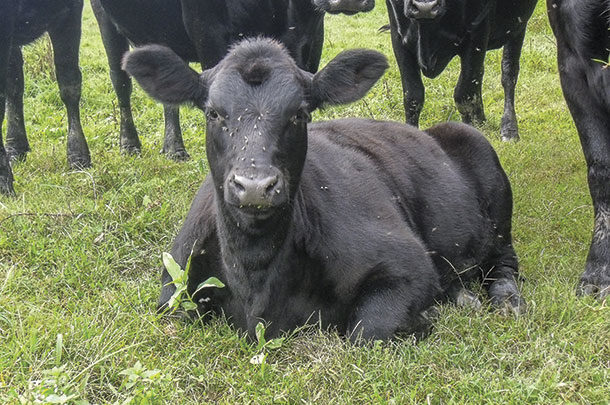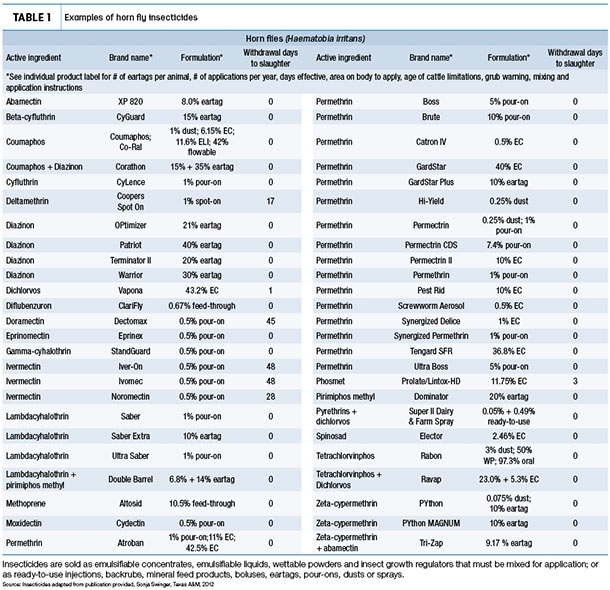It remains to be seen if the coming fly season is as bad as last year’s billion-a-day plague. Unfortunately, 2018’s fly explosion was predictive given the preceding fall’s saturated temperate conditions. This excessive moisture/high-fly-egg-laying scenario was repeated worldwide according to the NOAA’s November selected significant global climate anomalies and events report. Their total precipitation percentiles maps for 2018 show the fourth warmest January – November average temperatures and the wettest August and September on record for much of the U.S.
Knowing last fall was a perfect egg production season, what fly strategies will we need for 2019?
First, we have to know what fly species we are dealing with and when. There are over a dozen different types of flies and other biting insects that harass and harm livestock. Depending on your locality and the time of the year, you may be dealing with black flies, horn flies, stable flies, horse flies (aka deer flies), face flies, house flies, and also the blow fly, screwworm fly, cattle grub fly, mosquitos, lice, mites and ticks. Unfortunately, some or all of the above can occur at the same time.
For starters, let’s take a look at two of these pests, black flies and horn flies.
Female black flies
This time last year, black fly swarms were making headline livestock mortality news. There are over a hundred species in the genus simulium, and they all have the potential to bother cattle, but the saliva of simulium female flies (as males prefer nectar) is particularly toxic to cattle.
Black flies only emerge once a year, but the sheer size of 2018’s hatch was devastating to some producers’ herds.
Just like the reaction from too many bee stings, a swarm of female black flies can cause death by anaphylactic shock. Peter Mason, research scientist at Agriculture and Agri-Food Canada, Ottawa Research and Development
Centre, researched this pestilence phenomenon that ebbs and flows with weather anomalies. Extremely high populations of S. articum, S. luggeri and S. vittatum leading to documented cattle deaths occurred in the years 1955, 1956, 1961, 1963, 1964 and 1971 in Canada. But the deadliest outbreak goes to an extirpated brood of S. colombaschense. This particular population cumulatively killed 22,000 animals along the Danube River in Europe before the brood was destroyed by the construction of a reservoir.
Water management, scientists and cattle producers discovered, is the best solution to black fly control regardless of species. The larval habitat for most simulium species is slow-moving highly oxygenated shallow streams and rivers, but some species prefer reservoirs. The family has developed resistance to multiple modes of action since the days of DDT (dichloro diphenyl trichloroethane) and the frequent use of organophosphates like chlorphoxim and temephos, and the pyrethroids deltamethrin and fenvalerate. Michigan State University has created an arthropod pesticide-resistance tracking database where you can search by fly species for known cases of resistance to insecticides.
Insecticides used against black flies are essentially only repellents. While they are regulated as pesticide products by the EPA, repellents are not designed to eliminate pests. Skin-applied repellents do make people and animals less attractive. Most states have an active black fly suppression program where you can find out more about methods that target the larval habitat of black flies, including the use of biocontrols like Bacillus thuringiensis israelensis.
What can you do then? Livestock can be protected by putting distance between animals and streams, rivers and reservoirs where known broods will hatch. How far? Some researchers say 8 miles is far enough. But flies are known to travel five times that distance in search of a blood meal.
Post-hatch control: If you cannot put distance between predators and prey, supplying three-sided livestock shelters designed to reduce light penetration gives cattle respite from the day-long feeding frenzy. Flies do not like to fly into darkened enclosures. Forced use of backrubs as animals exit shelters will extend the relief time.
Male and female horn flies
This obligate blood feeder named Haematobia irritans mobs individual bovines by the thousands and arrived in the U.S. in 1887. The significance of high numbers per swarm per animal underscores the threshold problem, as it only takes 50 of these pests to seriously impact dairy animals. Two hundred or so of these feeding daily on beef animals without respite can impact gain significantly.
Horn flies hatch from manure every 10 to 14 days, and are voracious feeders multiple times a day. Their bites cause considerable skin lesions and hide damage. This is one reason why most hides, regardless of how attractive the markings, do not make it to the luxury tanned goods market.
Horn flies also transmit diseases, bacteria and pathogens, thus creating a chain reaction of herd illness. Williams Owens and colleagues at the Mastitis Research Laboratory, Hill Farm Research Station at the Louisiana State University Agricultural Center, conclusively showed in 1998 horn flies transmit Staphylococcus aureus-induced mastitis. Horn flies also transmit an underbelly dermatitis nematode called Stephanofilaria stilesi.
Prevention: In the absence of beneficial predatory and parasitoid insects that attack horn fly larva and pupae, breaking up manure deposits will reduce suitable habitat for egg laying. While daily dragging of pastures may not be possible, timed drags at the start of horn fly season can go a long way to reducing horn fly outbreaks if coupled with rotation. Hopefully, beneficial insects like soldier flies and dung beetles will take care of the paddies missed.
Insecticide control of horn flies is difficult given the species has developed resistance to 18 modes of action. But try we must. Keep in mind, insecticide and repellents are sold as emulsifiable concentrates, emulsifiable liquids, wettable powders and insect growth regulators. These must be mixed for application. Or they are sold as ready-to-use injections, backrubs, mineral feed products, boluses, eartags, pour-ons, dusts or sprays (see Table 1).
Click here or on the image above to view it at full size in a new window.
What about February’s arctic blast?
According to Justin Talley, extension livestock entomologist and principal investigator for Oklahoma State University’s National Tick Rearing Lab in Stillwater, the extreme cold that hit the Upper Midwest and Central Plains with minus 30ºF weather will have some impact on horn fly populations this spring.
“The temperature that will kill all life stages of horn flies is minus 4ºF, and since the temperatures went well below that, then it can be assumed some of the flies were killed.” Horn flies diapause underneath manure deposits, Talley said. “If the top 3 inches of the soil froze, then the horn fly population will probably be impacted. The polar vortex certainly impacted overwintering populations of horn flies under exposed manure pats in pastures.” More information on Talley’s research can be found online (Livestock Entomology - Oklahoma State University).
Air movement is a repellent: Remember those big ol’ barn fans? Get them out and rig them up to give your livestock a much-needed respite during the worst of fly season. There are even solar-powered “attic” fans that feasibly can synchronize the hottest part of the day with some much-needed air flow. According to Airtecnics air curtains against insects or fly fans you will need a fan that can blast at least 17 mph to keep flies out. But since most fans are rotating faster than the speed limit on a Texas highway, it shouldn’t be too hard to rig one up to work. ![]()
PHOTO: There are several different types of flies and other biting insects that harass and harm livestock. Photo by Melissa Bravo.

-
Melissa A. Bravo
- Certified Crop Adviser – Livestock and Forage Specialist
- Meadow Lake Farm Consulting
- Email Melissa A. Bravo









